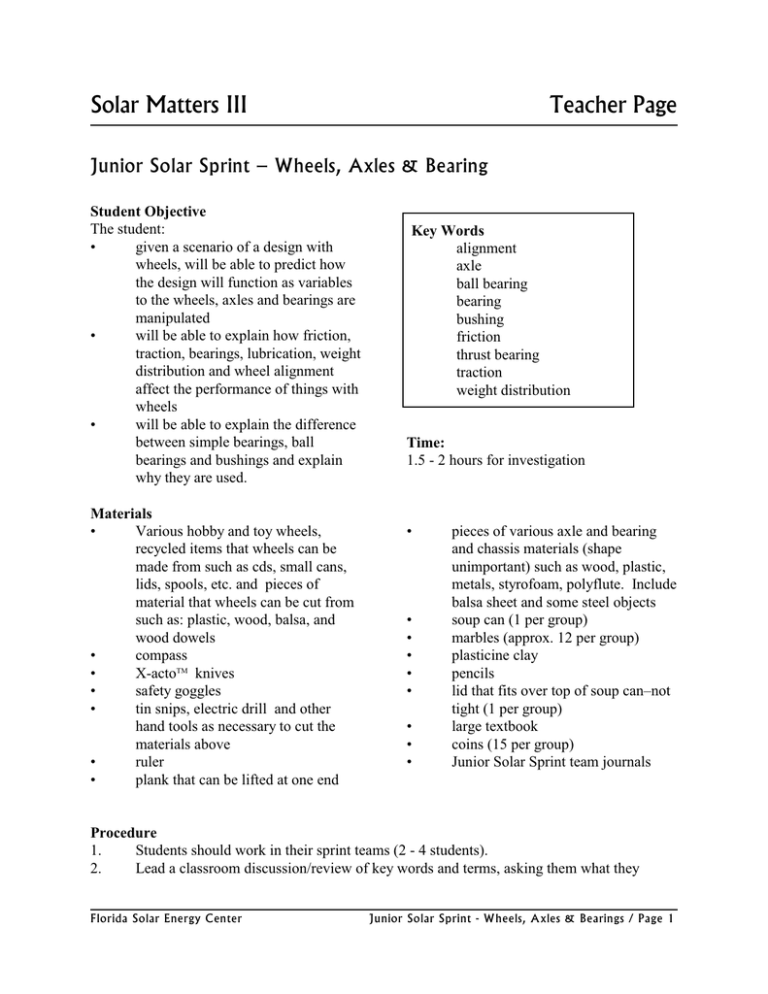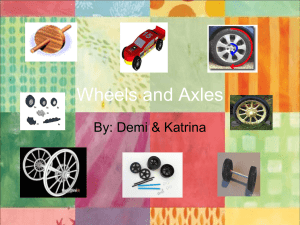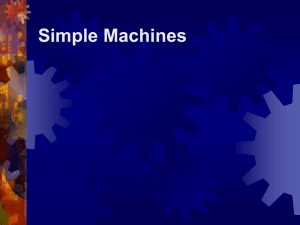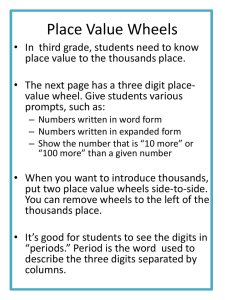Solar Matters III Teacher Page
advertisement

Solar Matters III Teacher Page Junior Solar Sprint – Wheels, Axles & Bearing Student Objective The student: • given a scenario of a design with wheels, will be able to predict how the design will function as variables to the wheels, axles and bearings are manipulated • will be able to explain how friction, traction, bearings, lubrication, weight distribution and wheel alignment affect the performance of things with wheels • will be able to explain the difference between simple bearings, ball bearings and bushings and explain why they are used. Materials • Various hobby and toy wheels, recycled items that wheels can be made from such as cds, small cans, lids, spools, etc. and pieces of material that wheels can be cut from such as: plastic, wood, balsa, and wood dowels • compass • X-actoTM knives • safety goggles • tin snips, electric drill and other hand tools as necessary to cut the materials above • ruler • plank that can be lifted at one end Key Words alignment axle ball bearing bearing bushing friction thrust bearing traction weight distribution Time: 1.5 - 2 hours for investigation • • • • • • • • • pieces of various axle and bearing and chassis materials (shape unimportant) such as wood, plastic, metals, styrofoam, polyflute. Include balsa sheet and some steel objects soup can (1 per group) marbles (approx. 12 per group) plasticine clay pencils lid that fits over top of soup can–not tight (1 per group) large textbook coins (15 per group) Junior Solar Sprint team journals Procedure 1. Students should work in their sprint teams (2 - 4 students). 2. Lead a classroom discussion/review of key words and terms, asking them what they Florida Solar Energy Center Junior Solar Sprint - W heels, Axles & Bearings / Page 1 3. 4. 5. 6. 7. already know about friction, traction, wheel alignment, weight distribution and bearings as it relates to automobiles, bicycles and skateboards. Some key points that you might want to make sure that they cover are: • friction wastes energy and slows down a vehicle • traction is ‘good’ friction, as in keeping a tire from slipping on the road. • wheels that are not aligned will affect performance Pass out, or have in stations the materials that all the groups will be using – soup cans, marbles, clay, lids, rulers, plank. Students can pick their materials for the wheel and axle/bushing investigations from a box of miscellaneous materials in the classroom. Students should complete the exercises in their Science Journal in groups. Encourage brainstorming of the scenarios in the exercises; teams should see how many solutions they can come up with. Give teams time to discuss how they plan to incorporate these findings in their vehicle design. Teams should sketch their ideas in their team journals. Teams should then continue constructing their vehicles. Key Words & Definitions • alignment – the position of parts in relation to each other, such as perpendicular or parallel. In wheel alignment, the proper alignment is rolling directly forward. • axle – a shaft that a wheel or a pair of wheels revolve on • ball bearing – a type of bearing that uses small balls to reduce friction. • bearing – the interface between two parts. In your JSS vehicle we will be referring to the interface between the axle and the chassis. This can be as simple as a hole, or as complex as bushings or ball bearings. • bushing – a smooth sleeve that gives the axle a low friction surface • friction – the resisting force between two materials that are in contact and moving past each other. Friction usually results in some energy being changed to heat. • thrust bearing – in your JSS vehicle it is a device that keeps the axle from falling out of the chassis. It can also keep the wheels from rubbing onto the side of the car • traction – friction that keeps two things from slipping; for example tire traction refers to how well the tire keeps from slipping on the road surface. • weight distribution – the arrangement of the weight in an object. Internet Sites http://www.exploratorium.edu/snacks/downhill_race/index.html Supplemental experiment/demonstration from the Exploratorium Teacher Institute demonstrating how the distribution of mass in a cylinder (wheel) affects how quickly an object accelerates. http://www.societyofrobots.com/mechanics_dynamics.shtml Humorous site discussing dynamics (acceleration, torque, wheel diameter, etc) in building motorized robots. The same basic principles apply to JSS cars. Florida Solar Energy Center Junior Solar Sprint - W heels, Axles & Bearings / Page 2 Solar Matters III Florida Next Generation Sunshine State Standards Junior Solar Sprint – Wheels, Axles & Bearing .1 .2 .3 .4 .5 X X .6 .7 .8 .9 .10 .11 .12 Grade 6 Practice of Science #1 SC.6.N.1 Theories, Laws, Hypothesis, Models #3 SC.6.N.3 Motion of Objects # 12 SC.6.P.12 X Forces & Changes in Motion # 13 SC.6.P.13 X Practice of Science #1 SC.7.N.1 X Energy Transfer & Transformations # 11 SC.7.P.11 Practice of Science #1 SC.8.N.1 Role of Theories, Laws, Hypotheses, and Models #3 SC.8.N.3 X X Grade 7 X Grade 8 X X X X Sixth Grade Benchmarks Science--Big Idea 1: The Practice of Science • SC.6.N.1.1 - Define a problem from the sixth grade curriculum, use appropriate reference materials to support scientific understanding, plan and carry out scientific investigation of various types, such as systematic observations or experiments, identify variables, collect and organize data, interpret data in charts, tables, and graphics, analyze information, make predictions, and defend conclusions • SC.6.N.1.4 - Discuss, compare, and negotiate methods used, results obtained, and explanations among groups of students conduction the same investigation. • SC.6.N.1.5 - Recognize that science involves creativity, not just in designing experiments, but also in creating explanations that fit evidence. Science–Big Idea 3: The Role of Theories, Laws, Hypothesis and Models • SC.6.N.3.4 - Identify the role of models in the context of the sixth grade science benchmarks. Florida Solar Energy Center Junior Solar Sprint - W heels, Axles & Bearings / Page 3 Science–Big Idea 12: Motion of Objects • SC.6.P.12.1 - Measure and graph distance versus time for an object moving at a constant speed. Interpret this relationship. Science–Big Idea 13: Forces and Changes in Motion • SC.6.P.13.1 - Investigate and describe types of forces including contact forces and forces acting at a distance, such as electrical, magnetic and gravitational. Seventh Grade Benchmarks Science--Big Idea 1: The Practice of Science • SC.7.N.1.1 - Define a problem from the seventh grade curriculum, use appropriate reference materials to support scientific understanding, plan and carry out scientific investigation of various types, such as systematic observations or experiments, identify variables, collect and organize data, interpret data in charts, tables, and graphics, analyze information, make predictions, and defend conclusions Science–Big Idea 11: Energy Transfer and Transformations • SC.7.P.11.2 - Investigate and describe the transformation of energy from one form to another. Eighth Grade Benchmarks Science--Big Idea 1: The Practice of Science • SC.8.N.1.1 - Define a problem from the eighth grade curriculum, use appropriate reference materials to support scientific understanding, plan and carry out scientific investigation of various types, such as systematic observations or experiments, identify variables, collect and organize data, interpret data in charts, tables, and graphics, analyze information, make predictions, and defend conclusions • SC.8.N.1.2 - Design and conduct a study using repeated trails and replication. • SC.8.N.1.6 - Understand that scientific investigations involve the collection of relevant empirical evidence, the use of logical reasoning, and the application of imagination in devising hypotheses, predictions, explanations and models to make sense of the collected evidence. Science–Big Idea 3: The Role of Theories, Laws, Hypotheses, and Models • SC.8.N.3.1 - Select models useful in relating the results of their own investigations. Florida Solar Energy Center Junior Solar Sprint - W heels, Axles & Bearings / Page 4 Solar Matters III Science Journal Junior Solar Sprint – Wheels, Axles & Bearing The purpose of the wheels is to move your vehicle as efficiently and quickly as possible. If you have not yet decided what kind of wheels you want to use on your vehicle, and how you are going to attach your wheels to your chassis, this investigation into some of the principals involved in the wheels, axles and bearings of your vehicle should give your team a place to start or a way to test your ideas. Part 1 – Wheels 1. Make a list of the different wheels that you could use. Include materials that you could make a wheel from as well as common items that could be turned into a wheel. Weight of Material 2. Choose six materials that you would like to investigate for wheels. These could be wheels from toys or raw materials that you could use to cut out wheels. Put the name of the material (for example – small lego wheel, or balsa wood) in the top row. In the second row, put the diameter of the wheel. For the raw materials such as balsa wood, cut a circle out of the material the size of the wheel you would like to investigate. Weigh each wheel and put the weight in the third row. Material Diameter Weight 3. Which wheel was the lightest? Florida Solar Energy Center Junior Solar Sprint - W heels, Axles & Bearings / Page 5 4. Why would the weight of the wheel be important? 5. Imagine that another team has decided to use a balsa wood wheel 3" in diameter. Without changing the diameter of the wheel, can you think of some ways that they could reduce the weight of the wheel? 6. Traction is important with any vehicle. Traction is the ‘gripping’ of the road by the wheels, and it is traction that enables the wheels to go forward rather than just spinning. Imagine that your group finds during the testing stage of your vehicle that your juice can lid wheels don’t have enough traction. What could you add to your wheels to increase their traction on the racing surface? 7. Weight distribution can also have an effect on traction. Imagine your group’s car from question 6 is still slipping even with the addition of ‘tires’. One of your team members suggests that you could use the weight of the motor to increase the traction. Remembering the weight distribution experiment from the previous chassis investigation, and adding what you know about traction, do you put the motor in the middle of the car, above the wheels that drive the car, or above the other set of wheels? Why? Florida Solar Energy Center Junior Solar Sprint - W heels, Axles & Bearings / Page 6 Part 2 – Axles 8. Axles need to be stiff, strong and very straight. Make a list of the different axles that your team could use. Include materials that you could make an axle from as well as common items that could be turned into an axle (for example a bicycle spoke or an umbrella rib). Part 3 – Bearings Friction is very undesirable in the wheel axle. The axle must be supported and attached to the chassis, but it still must be able to spin as freely as possible. Components which allow the relative motion of the two parts are called bearings. A plain bearing can be as simple as an axle running through a hole, or it could be a bushing. A bushing is a smooth sleeve that gives the axle a low friction surface to spin in. The illustration below shows some different bearing designs. Bearing Materials To choose the best materials for the axles and bearings you can test the friction between different types of materials. For instance, you can test the friction between metal (axle) and wood (bearing/chassis). The best bearing and axle combination will have the least amount of friction, allowing the axle to spin freely. This test will determine at what angle a sample piece of material overcomes the forces of gravity and friction and starts to slide. This test works because the Florida Solar Energy Center Junior Solar Sprint - W heels, Axles & Bearings / Page 7 weight of the object is not important. A steel paper clip will start sliding at the same angle as a heavy steel object. 9. Pick three sets of materials (axle/bearing) that you would like to test and put them in the top two rows of the chart below. Balsa and steel have already been picked for you. Taking one set of materials at a time, stack one on top of the other at one end of the plank. Slowly tilt the plank by raising the end that the materials are on, until the top object starts to slide just a little. Measure the height that the plank was raised and put that number in the chart below. Bearing Material Balsa Axle Material Steel Height plank was raised 10. Which combination of materials started to slide first (at the lowest plank angle)? 11. Does this mean that those materials have more or less friction between them? 12. What would you expect to happen if you coated these two pieces with a little bit of oil or powdered graphite? Ball Bearings A common type of bearing is the ball bearing. The following investigation demonstrates how a ball bearing works. 13. Make sure you have the following materials for the investigation: can, lid, pencil, clay, marbles (approximately 12). Attach 1" balls of clay to both ends of a pencil. Using another 1" ball of clay, securely attach the pencil by its midpoint to the center of the lid. Florida Solar Energy Center Junior Solar Sprint - W heels, Axles & Bearings / Page 8 The two ends of the pencil should extend like paddles from the top of the lid. Place the lid on top of the soup can. Spin the lid. Does the lid seem to spin easy or hard? 14. Take the lid off the can and put about 12 marbles on top. Place the lid back on top of the can. Spin the lid. Does the lid spin easier? 15. Why do you think this is so? Part 4 – Thrust bearings The thrust bearing keeps the axle from falling out of the side of the car and can keep the wheel from rubbing on the body of the car. 16. If there is something around the axles that let the center portion of the wheel touch first, the drag will be lower than if the outer part of the wheel touches. To demonstrate this, put a large heavy textbook flat on the table. Rotate it slowly back and forth to get a feel for how hard it is to turn. Next, put a stack of three coins on the table under the center of the book and balance the book on the coins. Make sure that the corners of the book don’t touch the table and try rotating the book slowly back and forth again. Was it easier or harder to turn the book with the coins underneath? 17. Why? Florida Solar Energy Center Junior Solar Sprint - W heels, Axles & Bearings / Page 9 18. Next, add a stack of coins under each corner and rotate the book slowly back and forth to get a feel for how hard it is to turn with a stack also on each corner. Then move the outer stacks of coins towards the center stack a little bit as a time, and test after each move (For example, try placing the coins approximately 4" apart, then 3", 2" and finally 1" apart.) Does it get easier or harder as the coins move toward the center? Discussion and Design With your group, discuss how you might use the findings from your investigations to help you design your Sprint vehicle. Remember, there are a lot of variables in the design of your vehicle, especially when you are designing moving parts! Your challenge here is to reduce friction on the vehicle, have enough traction on the surface, and to do it with the least amount of weight as possible! Here are some points to also consider: • A narrow wheel has a smaller ‘footprint’ than a wider wheel of the same diameter. This means less friction, but will you still have enough traction with the narrower wheel? • Poor wheel alignment can waste a lot of energy. When the wheels on your vehicle are not lined up properly, some of the wheels must slide sideways, or steer your vehicle off to the side creating extra friction on the steering wire. Make sure you double check your wheel alignment. When the car is not attached to the steering wire, does it go in a straight line? • Tires may not be necessary on your vehicle. If they are, narrow and firm tires will keep the rolling resistance (friction) low. • The faster the axle rotates in the bearing, the more friction and drag it will have. A larger wheel will allow the axle to rotate more slowly (if the car is to go at the same speed), and will waste less power in the bearings. • Sources of bearings could be brass or plastic tubing (drinking straws), parts from videocassettes, or screw eyes/eyebolts. Axles could be wooden rods, wire hangers, nails, and metal or plastic tubing. Materials that are rough or rubber-like and can be used to add traction are rubber o-rings, rubber bands, cloth tape or silicone caulking. Sources of wheels (or materials to make wheels from) could be toy wheels, thin plywood, foam core, tape spool, wood dowels, balsa wood, stiff plastic sheeting, thread spool, cds, small cans, and lids. • The axle needs to go through the absolute center of your wheel. If you make your own wheels, a compass is a great way to make sure you mark the center for your axle. Also, the wheels must be perfectly round! • You can either design your wheel and axle assembly to be one solid unit that rotates together, or you can design your wheel to spin on your axle by using wheels that have ball bearings in the hubs. If your wheels rotate with the axle, they must be firmly attached to the axle – slippage will cause a loss in momentum. Some manufactured wheels have a slightly smaller hole than the diameter of the axle. This is known as a ‘push-fit’, and is one way of making sure the two fit very tight. • If you choose to use a lubricant, different lubricants work better with different materials. Florida Solar Energy Center Junior Solar Sprint - W heels, Axles & Bearings / Page 10 • • Some appropriate lubricants for the solar car bearings may be light oil, light grease, or graphite powder. Experiment with several lubricants to find out what works best. Remember that the diameter of the drive wheels affect the final transmission ratio of your car – a larger wheel diameter gives a higher overall gear ratio. Gearing will be investigated in the next section. Test and retest your vehicle during different stages of construction. When you get your wheels attached to your chassis, check them to make sure they spin freely! You may even want to test a couple different types of wheels on a slanted board to see which rolls the easiest. Remember, it’s easier to change and modify your vehicle now than it is when it’s completely assembled. After you assemble and attach your wheels and axles to your chassis, be sure to perform a ‘spin test’ on each of your wheels. If your wheels do not spin freely you need to figure out what the problem is and correct it before going further on your vehicle’s construction. Florida Solar Energy Center Junior Solar Sprint - W heels, Axles & Bearings / Page 11



